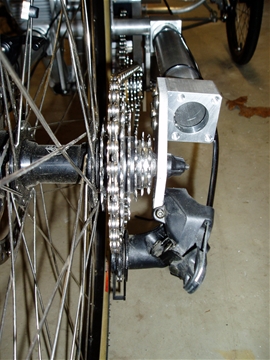Testing begins
Posted by Bob Dold on Sunday, November 19, 2006 8:58 PM
Completed the first test runs under electric power today, the first test was about 2.6 miles and unearthed a coupled of mild problems:
Test 1:
1. Chain from motor fell off after about a mile, this was being caused by the mid drive cog assembly unthreading from its hub and pulling the chain out of alignment. I believe this is a result of the rear hub not freewheeling correctly and the rear swingarm twisting from the motor torque.
2. The right rear dropout twisted down 5 or 10 degrees, the torque from the motor and chain drive apparently loosened the bond of this tube causing it to twist down. I will fix this by restoring the tube to the correct orientation and backing up the bond joint with several rivets to keep the tube from twisting in the socket.

3. The right disc brake was rubbing and making a lot of noise, adjusting the caliper position should fix this problem.
I attempted to get a shunt resistor from Radio Shack to measure the current draw using my voltage logger, but they did not stock any with the required .01 ohm resistance and 9 watt capacity. I ordered several from eBay and should have them in a couple of days, in the meantime I will use the average and total current and power measurements from the Drain Brain.

Test 2:
After fixing the rear dropout and adjusting the brakes I ran a second test lasting 1.9 miles. I added Loctite thread locker to the mid drive freewheel thread in hope of keeping it from unthreading, it seemed to have work as I did not notice any signs of it loosening. The new, stronger lower a-arms have eliminated the flexing of the old parts, but there is still more body roll than I would like in the corners. The table below shows the results of these two tests:

The Peukert range attempts to calculate what the range would be by using the average current from the test and the Peukert exponents which are characteristics of the battery model. The Peukert exponent and capacity were obtained using Uve’s battery calculator and the battery’s reserve capacity and 20 hour rating from the Odyssey website. Using the overly simplistic Time= AH Rating/Amps doesn’t account for discharge rate, a more accurate formula is:
Time = Capacity Number/Current^Peukert exponent
Since the exponent is in the denominator, the smaller it is the less capacity it loses at HIGH, not low, amp draw. To get the range in miles rather than time, the formula is:
Range (miles) = Capacity Number/(Speed * Current^Peukert exponent)
The first two test runs were run up ad down my street which is as close to level as I could get without traveling too far, by going down and back the average grade should average to zero. The elevation and grade plot from the Garmin GPS logger of the second test run is shown below:

Marcia said
I seldom leave a response, but after reading a bunch of comments
on this page Testing begins � Human Electric Trike
Thesis. I do have 2 questions for you if you do not mind.
Could it be simply me or does it give the impression like a few of the comments
look like they are left by brain dead visitors?
😛 And, if you are writing on additional online sites,
I’d like to follow you. Would you list of all of your social networking sites like your twitter feed, Facebook page or linkedin profile?